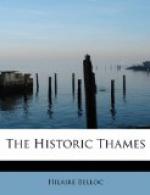In this connection the Thames is of an especial interest, for it had, in proportion to its length, the greatest section of navigable non-tidal water of any of the shorter rivers in Europe. Until the digging of the Thames and Severn Canal at the end of last century it was possible, and even common, for boats to reach Cricklade, or at any rate the mouth of the Churn. And even now, in spite of the pumping that is necessary at Thames head and the consequent diminution of the volume of water in the upper reaches, the Thames, were water carriage to come again into general use, would be a busy commercial stream as high up as Lechlade.
This exceptional sector of non-tidal navigable water cutting right across England from east to west, and that in what used to be the most productive and is still the most fertile portion of the island, is the chief factor in the historic importance of the Thames.
From Cricklade to the navigable waters of the Severn Valley is but a long day’s walk; and one may say that even in the earliest times there was thus provided a great highway right across what then was by far the most thickly populated and the most important part of the island.
A third section in all such rivers (and, from what we have said above, a short and insignificant one in the case of the Thames) may be called the head-waters of the river: where the stream is so shallow or so uncertain as to be no longer navigable. In the case of the Thames these head-waters cover no more than ten to fifteen miles of country. With the exception of rivers that run through mountain districts this section of a river’s course is nearly always small in proportion to the rest; but the Thames, just as it has the longest proportion of navigable water, has also by far the shortest proportion of useless head-water of all the shorter European rivers.
There is a further discussion as to what is the true source of the Thames, and which streams may properly be regarded as its head-waters: the Churn, especially since the digging of the canal, having a larger flow than the stream from Thames head; but whichever is chosen, the non-navigable portion starts at the same point, and is the third of the divisions into which the valley ranges itself when it is considered in its length, as a highway from the west to the east of England. The two limits, then, are at London Bridge and at Cricklade, or rather at some point between Lechlade and Cricklade, and nearer to the latter.
But a river has a second topographical and historic function. It cannot only be considered longitudinally as a highway, it can also be considered in relation to transverse forces and regarded as an obstacle, a defence, and a boundary.
This function has, of course, been of the highest importance in the history of all great rivers, not perhaps so much so in the case of the Thames as in the case of swifter or deeper streams, but, still, more than has been the case with so considerable and so rapid a river as the Po in Lombardy or the uncertain but dangerous Loire in its passage through the centre of France. For the Thames Valley was that which divided the vague Mercian land from which we get our weights, our measures, and the worst of our national accent, and cut it off from that belt of the south country which was the head and the heart of England until the last industrial revolution of our history.




